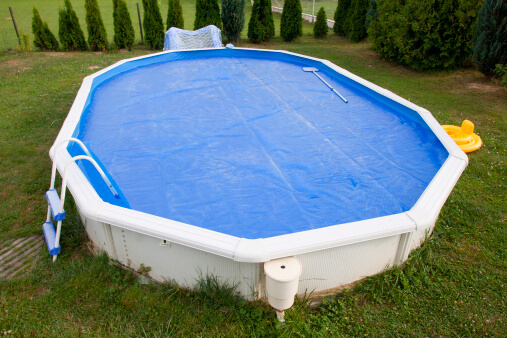
Choose the Right Pool Cover: 12 Key Factors
There are approximately 8 million residential pools in the US. Roughly 56% are in-ground and 34% are above-ground models, and both perform better with the right pool cover. When you’re choosing a cover, focus first on practical matters such as operation, primary purpose and material.
Operation
There are three types of operation:
- Manual. The cover must be put in place and removed by hand. Options range from light covers that simply float on the surface to those that are mounted on poles so they can be rolled and unrolled with a hand crank. Some are secured with side tracks while others require snap strips or tie-downs around the pool perimeter. For obvious reasons, light weight covers suited to smaller pools are easier to handle.
- Semi-automatic. The cover is stored on a pole and relies on a motorized reel to extend and retract it. Typically you have to manually guide the cover into place.
- Automatic. Fully automatic versions are the most convenient. Motorized components extend and retract the cover which is attached to sidetracks that guide the edges.
Purpose
Basically, pool covers are designed to accomplish one or more of the following:
- Reduce cleaning and maintenance.
- Conserve water by minimizing evaporation.
- Manage solar gain, heat loss and energy use.
- Increase safety.
- Provide protection seasonally or year-round.
Material
The most common pool cover materials include:
- Mesh. Constructed of finely woven polyethylene, mesh covers are designed to capture twigs, leaves and debris. Used alone or over a solid cover, they reduce cleaning requirements but don’t affect evaporation loss, heat gain or energy requirements.
- Bubble. A heavyweight version of bubble wrap, most are designed to simply float on the water surface. They slow evaporation and heat loss, and increase water temperature by about 10 degrees which reduces heater use.
- Vinyl. The most versatile material by far, vinyl covers come in light, medium and heavy duty versions. They can reduce evaporation by up to 95%, minimize overnight heat loss and decrease solar gain by up to 40%. Insulated versions provide year-round protection.
- Liquid. Formulated with isopropyl alcohol and proprietary compounds, liquid covers coat the water surface to reduce evaporation and minimize heat loss. Biodegradable and safe for swimmers, they’re less effective than barrier covers but work continuously. Some feature an automatic applicator for hassle-free care.
To choose the pool cover that’s right for you, consider what you want and need the cover to do. Weigh the advantages and disadvantages of different operations, purposes and materials then pick a combination that meets your core requirements and suits your budget. From safety and convenience to water conservation, high-end automatic versions offer the most comprehensive benefits, but you can often find most if not all of these advantages in mid-range pool covers as well.